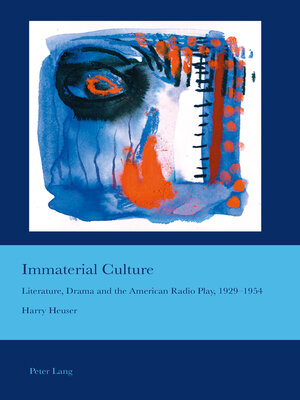Immaterial Culture
ebook ∣ Literature, Drama and the American Radio Play, 19291954 · Cultural Interactions: Studies In the Relationship Between the Arts
By J. Barrie Bullen

Sign up to save your library
With an OverDrive account, you can save your favorite libraries for at-a-glance information about availability. Find out more about OverDrive accounts.
Find this title in Libby, the library reading app by OverDrive.



Search for a digital library with this title
Title found at these libraries:
| Library Name | Distance |
|---|---|
| Loading... |
Immaterial Culture engages with texts that are now largely unread and dismissed as trivial or dubious: the vast body of plays – thrillers, narrative poetry, comedy sketches, documentaries and adaptations of literature and drama – that aired on American network radio during the medium's so-called golden age.
For a quarter century, from the stock market crash of 1929 to the introduction of the TV dinner in 1954, radio plays enjoyed an exposure unrivalled by stage, film, television and print media. As well as entertaining audiences numbering in the tens of millions for a single broadcast, these scripted performances – many of which were penned by noted novelists, poets and dramatists – played important and often conflicting roles in advertising, government propaganda and education.
Reading these fugitive and often self-conscious texts in the context in which they were created and presented, the author considers what their neglect might tell us about ourselves, our visual bias and our attitudes toward commercial art and propaganda. The study's ample scope, its interdisciplinary approach and its insistence on the primacy of the texts under discussion serve to regenerate the discourse about cultural products that challenge the way we classify art and marginalise the unclassifiable.
For a quarter century, from the stock market crash of 1929 to the introduction of the TV dinner in 1954, radio plays enjoyed an exposure unrivalled by stage, film, television and print media. As well as entertaining audiences numbering in the tens of millions for a single broadcast, these scripted performances – many of which were penned by noted novelists, poets and dramatists – played important and often conflicting roles in advertising, government propaganda and education.
Reading these fugitive and often self-conscious texts in the context in which they were created and presented, the author considers what their neglect might tell us about ourselves, our visual bias and our attitudes toward commercial art and propaganda. The study's ample scope, its interdisciplinary approach and its insistence on the primacy of the texts under discussion serve to regenerate the discourse about cultural products that challenge the way we classify art and marginalise the unclassifiable.







